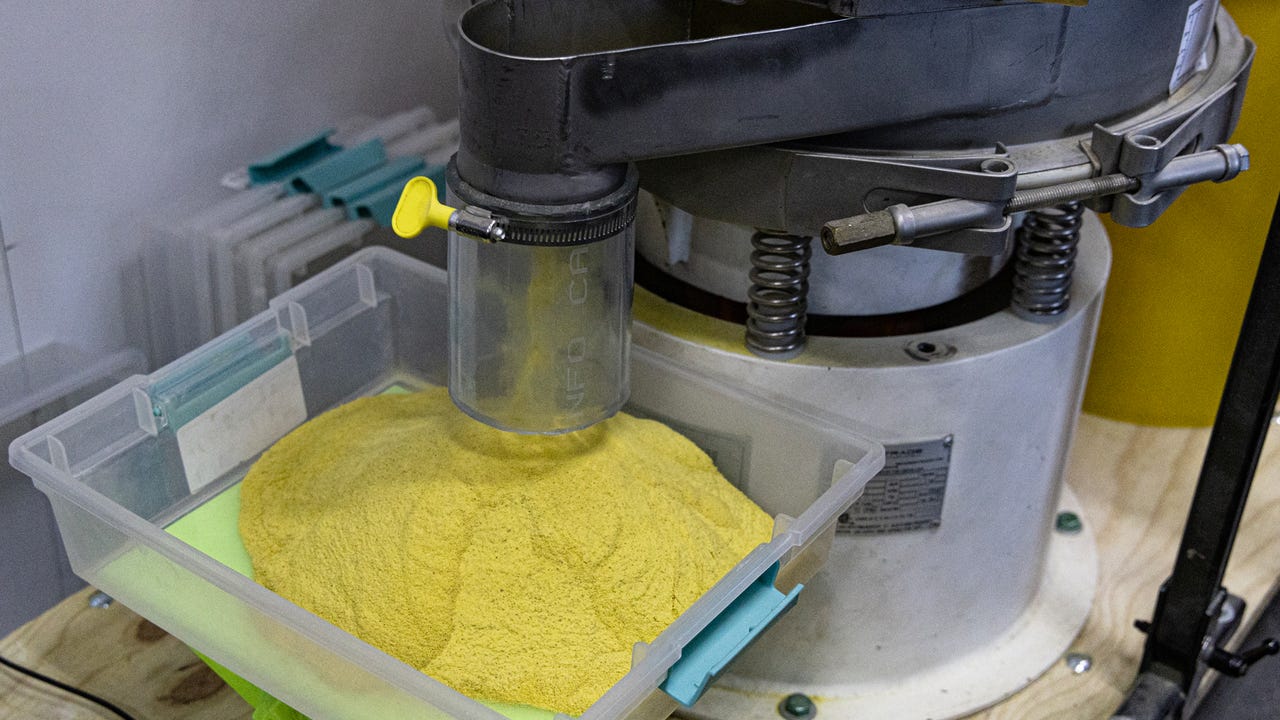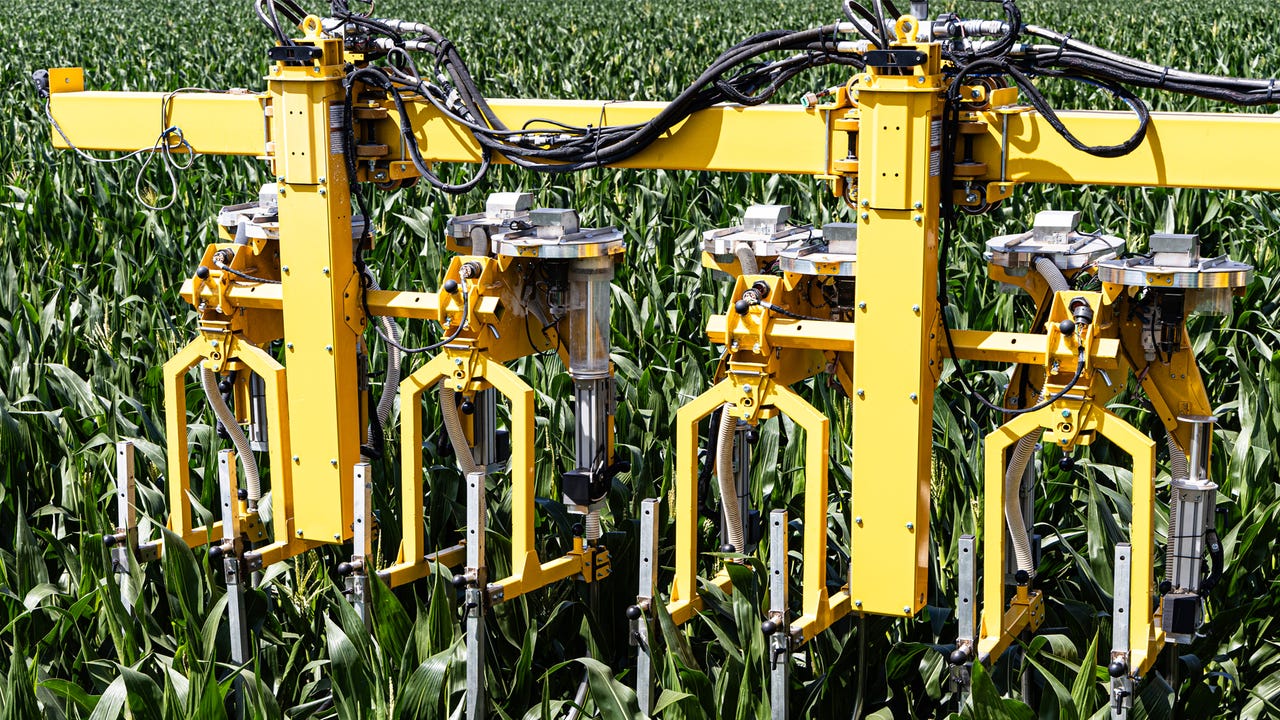The scene mimics the urgency of a patient wheeled into a hospital emergency room. Any treatment delay will be fatal. Fortunately, technicians work to quickly defeat death on this day.
In this case, though, the “patient” is corn pollen. The emergency room is an air-conditioned mobile shed located at the edge of a central Iowa cornfield. Inside, technicians for PowerPollen, an Ames, Iowa, firm, clean and condition corn pollen before refrigerating it for future use.
Just as in a hospital emergency room, time is of the essence. If pollen is not refrigerated 30 to 45 minutes after it falls from a corn tassel, it dies.
Controlling pollination
All of this is part of an effort by PowerPollen to improve nature’s impact on corn pollination.
Pollen shed from a tassel’s anthers often occurs in a “here and there, maybe once in a while” fashion during a 10- to 14-day period. Cool, cloudy or humid weather delays pollen shed. Rainy conditions halt it, notes Mark Licht, Iowa State University Extension agronomist.
 POLLEN COLLECTION: PowerPollen collects pollen during pollination with a harvest machine that’s unloaded after every round. Pollen then goes immediately into processing and refrigerated storage.
POLLEN COLLECTION: PowerPollen collects pollen during pollination with a harvest machine that’s unloaded after every round. Pollen then goes immediately into processing and refrigerated storage.
Conversely, Bob Nielsen, a retired Purdue University Extension agronomist, found that during the silking and pollen-shed period, severe moisture stress may reduce yield up to 8% per day.
“We provide the ability to de-risk and control the pollination process,” says Jason Kelsick, PowerPollen senior director of engineering. “We can put pollen on the silks at the right time and conditions to create kernels that produce the highest yield.”
Boosting seed corn production
PowerPollen is first aiming to improve seed corn pollination.
“[Pollination] changes within a field can have a huge impact on [seed companies’] bottom line,” Kelsick says. “There may be males shedding pollen, but the silks on the females have not emerged for pollination to occur. Sometimes, male plants may not be producing enough pollen.”
PowerPollen’s short-term strategy is to fill such pollination gaps. It uses a pollen harvester to glean pollen from tassels during pollination. Pollen is quickly cleaned, processed and refrigerated within the 30- to 45-minute survival window. The company supplements seed cornfields with pollination problems with the gleaned pollen in several days during an optimum pollination window. PowerPollen uses an automated guidance pollen applicator with tubes that ferry the pollen onto silks.
 POLLEN PROCESSING: After pollen is harvested, it is cleaned before undergoing further processing and refrigeration for future use.
POLLEN PROCESSING: After pollen is harvested, it is cleaned before undergoing further processing and refrigeration for future use.
PowerPollen also is developing a long-term strategy to boost seed corn pollination efficiency. Seed companies often use a ratio of one male plant to provide pollen to four female plants in seed cornfields, says Jake Klocke, PowerPollen engineering manager.
“The closer female plants are to a male row, the better the pollination,” he says.
PowerPollen’s strategy to increase seed yields is by using viable pollen stored up to five years to pollinate female plants farther away from male plants. For example, a 12:1 female-to-male ratio boosts 10% more kernel-producing rows compared with a 4:1 ratio, Klocke says.
Eventually, the company aims to nix male plants (that are currently destroyed prior to kernels maturing) and apply pollen through a field filled with just female plants. This will ensure each plant produces seed, Klocke says.
“Instead of just going in for a rescue situation, we can build a whole new risk-free system for pollination,” Kelsick says.
PowerPollen currently is working with several seed companies on this process.
“The ability to collect, store and distribute pollen remains an intriguing concept for Corteva. It is a technology that we continue to evaluate,” a Corteva spokesperson said in a prepared statement.
PowerPollen also is aiming its technology for such use on commercial cornfields, says Jeff Taylor, an Ames, Iowa, farmer who also is a PowerPollen board member.
In limited company tests, proprietary pollen blends have increased yields 7% to 8%, Taylor says. At a 200-bushel-per-acre corn yield level, that’s about another 15 bushels per acre. When priced at $4 per bushel, this grosses an additional $60 per acre.
Traits via pollination
During the 1990s, high-oil corn was prized by livestock producers for its energy-dense content. This led to seed companies developing a number of high-oil corn hybrids. Since farmers could glean high-oil premiums, the thinking was that these hybrids couldn’t miss.
They missed.
“The challenge farmers growing them faced was yield drag,” says Taylor, who also is chairman of Lincolnway Energy, an Ames ethanol plant. “Corn with a high oil content takes away from yield potential due to the amount of energy used by the plant to produce the oil.”
 POLLEN APPLICATION: PowerPollen’s pollen applicator machine with automated guidance drops pollen through the corn so that silks may be pollinated.
POLLEN APPLICATION: PowerPollen’s pollen applicator machine with automated guidance drops pollen through the corn so that silks may be pollinated.
Not so with today’s high-oil corn trait. Since the kernel’s oil production trait is delivered via pollen, this strategy eliminates any associated risk of yield drag, PowerPollen officials say. Thus, a farmer can plant modern elite hybrids while still adding kernel composition components through pollen, they add.
These days, high-oil corn also is prized by ethanol plants as a co-product that creates another revenue stream. This demand has led to corn oil prices rising from about 25 cents per pound to 75-80 cents per pound at times, Taylor says.
By adding value to the ethanol plant, the belief is farmers could glean a premium for high-oil corn, he adds. If successful, Taylor believes the process also could introduce traits for other niches, such as hybrids containing certain amino acids.
Ethanol plants can process high-oil corn with little adjustment, Taylor says. In 2023, PowerPollen collaborated with Lincolnway Energy in a trial in which farmers grew 700,000 bushels of corn for blending with corn with a high-oil trait.
“We were able to capture an extra pound of corn oil per bushel without affecting our daily grind at a 25% to 30% blend [corn oil] rate,” he says. Even with corn oil priced at 40 cents per pound, a 200-bushel-per-acre yield would create an extra $80 per acre in value split between the technology provider, ethanol plant and farmer, Taylor adds.
Still, the 1990s millstone of yield drag occurred at a 3% to 5% rate in the 2023 trial. That’s why the next step will be PowerPollen machines pollinating fields midseason. If similar 7% to 8% yield bumps occur as in previous PowerPollen test, the yield drag hurdle would be nixed, Taylor says.
Scaling up
PowerPollen officials continue to refine the company’s processes for efficiency and scaling up for more acres.
“[PowerPollen’s process] has the potential to be an innovative change in technology, similar to the beginnings of hybridization of corn,” Kelsick says.